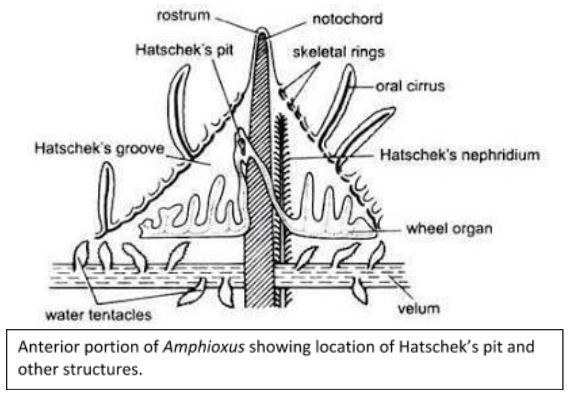
The roof of oral hood in Amphioxus show the presence of Hatschek's pit which is responsible for the secretion of
A. Bile
B. Saliva
C. Mucus
D. Amylase
Answer
585.9k+ views
Hint: The secretion from Hatschek's pit cells help entrapping food particles in the water.
Complete answer: Amphioxus is a modern representative of the Cephalochordata subphylum.
It is a marine Chordate animal. Zoologists take much interest in these animals because they provide evolutionary facts about the origins of vertebrates. These are commonly known as ‘sea lancelets’ due to their characteristic shape of head.
They contain many organs and systems that closely resemble those of modern fishes, though in a primitive form. The gill-slits of sea lancelets are used for feeding, not for respiration. Their circulatory system transports food throughout their body, though it does not have RBC or haemoglobin.
The roof of the oral hood in Amphioxus shows the presence of a unique structure. Here, the second rostral groove is known as Hatschek's pit. It should not be confused with Hatschek’s nephridium. Hatschek's pit is a deep ciliated fossa on the dorsal midline of the buccal cavity. Studies have shown the presence of some granulated cells in the epithelial lining of this pit. Along with ciliated cells it is responsible for the secretion of mucus. The secreted mucus helps to entrap food particles from the water.

So, the correct answer is C. Mucus.
Note: Feeding method of Amphioxus is a reflection of their habitat; they expose their anterior portion to the water and feed on plankton by the action of branchial ciliary current which passes water through the mucous sheet- this is called filter-feeding.
Complete answer: Amphioxus is a modern representative of the Cephalochordata subphylum.
It is a marine Chordate animal. Zoologists take much interest in these animals because they provide evolutionary facts about the origins of vertebrates. These are commonly known as ‘sea lancelets’ due to their characteristic shape of head.
They contain many organs and systems that closely resemble those of modern fishes, though in a primitive form. The gill-slits of sea lancelets are used for feeding, not for respiration. Their circulatory system transports food throughout their body, though it does not have RBC or haemoglobin.
The roof of the oral hood in Amphioxus shows the presence of a unique structure. Here, the second rostral groove is known as Hatschek's pit. It should not be confused with Hatschek’s nephridium. Hatschek's pit is a deep ciliated fossa on the dorsal midline of the buccal cavity. Studies have shown the presence of some granulated cells in the epithelial lining of this pit. Along with ciliated cells it is responsible for the secretion of mucus. The secreted mucus helps to entrap food particles from the water.

So, the correct answer is C. Mucus.
Note: Feeding method of Amphioxus is a reflection of their habitat; they expose their anterior portion to the water and feed on plankton by the action of branchial ciliary current which passes water through the mucous sheet- this is called filter-feeding.
Recently Updated Pages
The number of solutions in x in 02pi for which sqrt class 12 maths CBSE

Write any two methods of preparation of phenol Give class 12 chemistry CBSE

Differentiate between action potential and resting class 12 biology CBSE

Two plane mirrors arranged at right angles to each class 12 physics CBSE

Which of the following molecules is are chiral A I class 12 chemistry CBSE

Name different types of neurons and give one function class 12 biology CBSE

Trending doubts
Which are the Top 10 Largest Countries of the World?

What are the major means of transport Explain each class 12 social science CBSE

Draw a labelled sketch of the human eye class 12 physics CBSE

Differentiate between insitu conservation and exsitu class 12 biology CBSE

The computer jargonwwww stands for Aworld wide web class 12 physics CBSE

State the principle of an ac generator and explain class 12 physics CBSE




